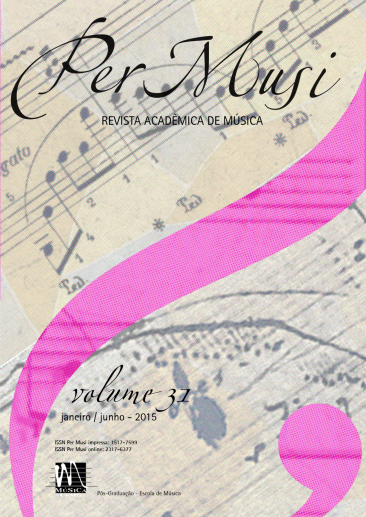Agência dos objetos sonoros
Palavras-chave:
Estéticas ameríndias, Criação musical, Políticas da estéticaResumo
Este texto busca se aproximar do discurso de especialistas ameríndios sobre a origem não autoral de suas músicas, onde a escuta ocupa a função de produção. Busca também compreender as limitações dos artistas ocidentais quando tentam colaborar com as formas de trabalho acústico operantes entre estes coletivos. À luz de reflexões de Bruno Latour e Jacques Rancière em torno de temas relacionados às políticas da estética, às noções de “produção” e às fissuras construídas pelas sociedades modernas entre noções de natureza e cultura, é revisitado o percurso singular do compositor francês Pierre Boulez, como forma de problematizar um encontro da produção artística musical dos círculos de compositores de salas de concerto com as cosmossonologias ameríndias.
Referências
BOULEZ, Pierre. Penser la musique aujourd’hui. Paris, Gonthier, 1964. Tradução brasileira: Reginaldo de Carvalho e Mary Amazonas Leite de Barros: A Música Hoje. S.P., Ed. Perspectiva, 1972.
______. Relevés d’apprenti. Paris: Seuil, 1966.
______. Points de repère. Paris: Christian Bourgois Éditeur, Édition du Seuil, 1981.
______. Musiques traditionnelles – un paradis perdu?» In The World of Music Quartely Journal of the International Music Council (UNESCO). Bärenreiter, IX/2, 1967.
______. Existe-t-il un conflit entre la pensée européenne et non-européenne?» Europäische Musik zwischen Nationalismus und Exotic, (ed. Hans Oesch, Wulf Arlt & Max Haas), Winterthur: Amadeus, 1984.
______. Penser la Musique Aujourd’hui, Paris: Gallimard, rééd. coll. « Tel », 1963.
______. Constellation-Miroir. Troisième Sonate pour piano. Formant 3. Universal Edition UE 13293 (b) [2a edição: 1993]
______. (MS) Constellation (formant 3). Paul Sacher Stiftung (Basiléia) Microfilme 138 - 0810 à 859.
DELEUZE, Gilles & GUATTARI, Félix. L´Anti-Oedipe. Paris: Les Éditions de Minuit, 1972.
CLASTRES, Pierre. (1974). “A Sociedade contra o estado”. In: A sociedade contra o estado, trad. De Theo Santiago, Cosac & Naify, 2003.
______. Mil platôs v. 4. Rio de Janeiro: Editora 34, 2005[a].
______. Mil platôs v. 5. Rio de Janeiro: Editora 34, 2005[b].
______. Qu’est-ce que la philosophie? Paris: Les Éditions de Minuit, 1991.
DERRIDA, Jacques. [1967] Gramatologia. São Paulo: Perspectiva, 1999.
GELL, Alfred. Art and Agency: an Antropological Theory, Oxford: University Press, 1988.
LAGROU, Els. A fluidez da forma: arte, alteridade e agência em uma sociedade amazônica (Kaxinawa, Acre), Rio de Janeiro: TopBooks, 2007, 565 p.
LATOUR, Bruno. Jamais fomos modernos. Ensaio de antropologia simétrica. Tradução: Carlos Irineu da Costa. São Paulo: Editora 34 [1991], 2005.
______. Reflexão sobre o culto moderno dos deuses fe(i)tiches. Bauru: Edusc, [1996], 2002.
______. « Factures/fractures. De la notion de réseaux à celle d’attachement ». in (André Micoud et Michel Peroni) Ce qui nos relie, Editon de l’Aube, La Tour d’Aigues, p.189-208.
LÉVI-STRAUSS, Claude. O cru e o cozido. (tradução: Beatriz Perrone-Moisés), São Paulo: Cosac Naify, 2004a.
______. Do mel às cinzas. (tradução: Beatriz Perrone-Moisés), São Paulo: Cosac Naify, 2004b.
______. Origem dos modos à mesa. (tradução: Beatriz Perrone-Moisés). São Paulo: Cosac Naify, 2006.
______. L’Homme nu, Paris: Plon, 1971.
MALLARME, Stéphane. Oeuvres complètes. (editor: Henri Mondor e G. Jean-Aubry). Paris: Gallimard, 1945.
NIEZSCHE, Frederich. O nascimento da tragédia ou helenismo e pessimismo. Tradução de J. Guinsburg. São Paulo: Companhia das Letras, 1992.
RANCIÈRE, Jacques. Jacques Rancière. Malaise dans l´esthétique, Paris: Galilée, 2004. Tradução de Augustin de Tugny: Devires, Belo Horizonte, v.7, n.2, jul/dez 2010, p.4-24.
TUGNY, R. P. Le piano et les dés. Étude sur Music of Changes, Klavierstück XI et Constellation-Miroir. Tese (Doutorado em Musica e Musicologia). Université de Tours. France, 1996.
______. “Des Glissements dans le Temps”. Musicorum. Tours, França, v.2, p.13 -32, 2004.
______. “L'autre moitié de l'art”. Pierre Boulez. Techniques d´écriture et enjeux esthétiques. Editores: Jean-Louis Leleu & Pascal Decroupet. Genève: Éditions Contrechamps, 2006, v. 1, p. 299-317.
______. “O trem do progresso” 2011. Espaço Público Periódico, http://piseagrama.org/artigo/333/trem-do-progresso/
STRINZ, Werner. “Quelques observations sur des “Objets retrouvés” dans l’oeuvre de Pierre Boullez ». Pierre Boulez. Techniques d´écriture et enjeux esthétiques. Editores: Jean-Louis Leleu & Pascal Decroupet. Genève: Éditions Contrechamps, 2006, v. 1, p p. 45-93.
SEEGER, Anthony. Why Suyá Sing. Cambridge: Cambridge University Press, 1987 SLOTERDIJK, Peter. Regras para o parque humano. (Tradução: Marques, Jose Oscar de Almeida). São Paulo: Editora Estação Liberdade, 2000.
VALLAS, Léon. Claude Debussy et son temps. Paris: Alcan, 1932 [réedit. Albin Michel, 1958].
VIVEIROS DE CASTRO. A inconstância da alma selvagem. São Paulo: Cosac & Naify, 2002.
______. 2002b “O nativo relativo”. In Mana n.8, Rio de Janeiro, p.113-148.
Downloads
Publicado
Edição
Seção
Licença
Copyright (c) 2015 Per Musi

Este trabalho está licenciado sob uma licença Creative Commons Attribution 4.0 International License.

Exceto onde está indicado, o conteúdo neste site está sob uma Licença Creative Commons - Atribuição 4.0 Internacional.












